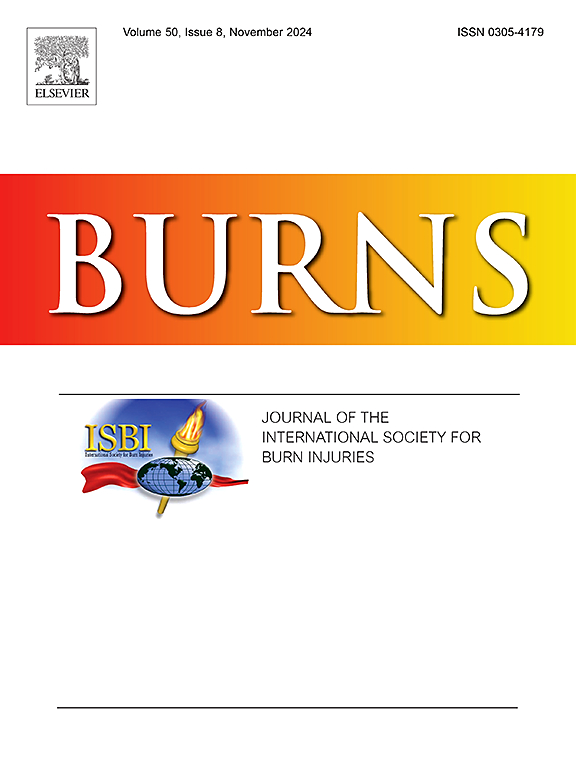Persistent inflammation, immunosuppression, and catabolism syndrome and sepsis in pediatric burns
IF 2.9
3区 医学
Q2 CRITICAL CARE MEDICINE
引用次数: 0
Abstract
Objective
To determine the prevalence of persistent inflammation, immunosuppression, and catabolism syndrome (PIICS) and associated sepsis in children with burn injuries at a single, large institution over the past 25 years.
Background
Despite advances in care, sepsis after burn injury continues to have a significant contribution to morbidity and mortality. This risk is compounded by an altered immune state after burn injury that can induce PIICS. While the presence of this dysregulated immunophenotype in pediatric burns is widely accepted, it remains poorly characterized.
Methods
We performed a retrospective analysis of pediatric burn injuries utilizing an institutional database with de-identified patient records (1997–2023).
Results
In the cohort of 287 patients, the overall prevalence of sepsis and PIICS among burn-injured children was 30 % and 15 %, respectively. The presence of inhalation injury and the total body surface area (TBSA) burned were both strongly associated with the development of sepsis and PIICS. While those with PIICS had more infections per patient compared to patients without PIICS, there was no difference in the pathogen profile between the two groups. Having PIICS itself was independently associated with the development of sepsis, and among the laboratory and clinical criteria, we found that lymphopenia had the strongest association.
Conclusion
PIICS occurred in approximately 1 in 6 pediatric patients with burn injury. The development of PIICS is closely associated with the development of sepsis during hospitalization. Among the laboratory and clinical criteria, lymphopenia was most strongly associated with a septic event, suggesting that its presence should heighten concern about the development of serious infections in this vulnerable population.
儿童烧伤的持续性炎症、免疫抑制、分解代谢综合征和败血症
目的了解25年来某大型医院烧伤患儿持续炎症、免疫抑制和分解代谢综合征(PIICS)及相关脓毒症的患病率。背景:尽管在护理方面取得了进步,但烧伤后脓毒症仍然是导致发病率和死亡率的重要因素。烧伤后免疫状态的改变可诱发PIICS,这一风险进一步加剧。虽然这种失调的免疫表型在儿童烧伤中被广泛接受,但它仍然缺乏特征。方法:我们利用一个机构数据库对1997-2023年的儿童烧伤病例进行回顾性分析。结果287例患者中,烧伤患儿脓毒症和PIICS的总体患病率分别为30% %和15% %。吸入性损伤和烧伤的总体表面积(TBSA)与脓毒症和PIICS的发生密切相关。虽然与没有PIICS的患者相比,PIICS患者的感染人数更多,但两组之间的病原体特征没有差异。PIICS本身与脓毒症的发展独立相关,在实验室和临床标准中,我们发现淋巴细胞减少与脓毒症的发展有最强的关联。结论小儿烧伤患者中约有1 / 6发生piics。PIICS的发生与住院期间脓毒症的发生密切相关。在实验室和临床标准中,淋巴细胞减少症与脓毒症事件的关系最为密切,这表明淋巴细胞减少症的存在应引起人们对这一脆弱人群发生严重感染的关注。
本文章由计算机程序翻译,如有差异,请以英文原文为准。
求助全文
约1分钟内获得全文
求助全文
来源期刊

Burns
医学-皮肤病学
CiteScore
4.50
自引率
18.50%
发文量
304
审稿时长
72 days
期刊介绍:
Burns aims to foster the exchange of information among all engaged in preventing and treating the effects of burns. The journal focuses on clinical, scientific and social aspects of these injuries and covers the prevention of the injury, the epidemiology of such injuries and all aspects of treatment including development of new techniques and technologies and verification of existing ones. Regular features include clinical and scientific papers, state of the art reviews and descriptions of burn-care in practice.
Topics covered by Burns include: the effects of smoke on man and animals, their tissues and cells; the responses to and treatment of patients and animals with chemical injuries to the skin; the biological and clinical effects of cold injuries; surgical techniques which are, or may be relevant to the treatment of burned patients during the acute or reconstructive phase following injury; well controlled laboratory studies of the effectiveness of anti-microbial agents on infection and new materials on scarring and healing; inflammatory responses to injury, effectiveness of related agents and other compounds used to modify the physiological and cellular responses to the injury; experimental studies of burns and the outcome of burn wound healing; regenerative medicine concerning the skin.
 求助内容:
求助内容: 应助结果提醒方式:
应助结果提醒方式:


